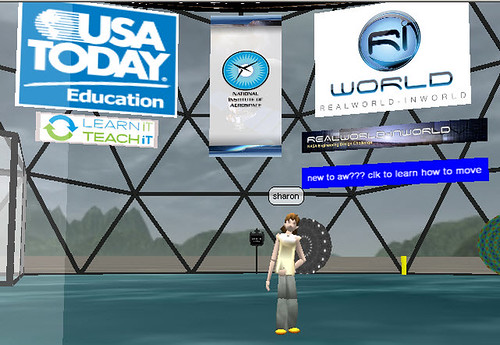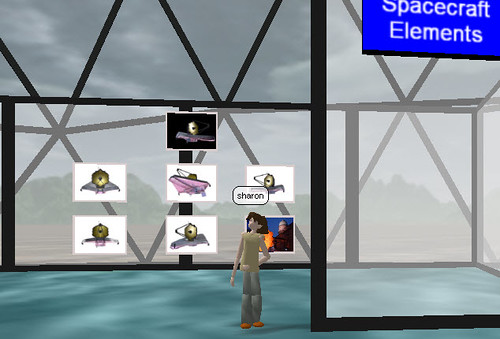Solving Real World Problems Virtually!
- By Maggie Masetti
- September 8, 2010
- 2 Comments
Those of us who work on education and outreach for the James Webb Space Telescope have wanted to do an engineering design challenge for a long time. The chance finally presented itself in the form of a teacher from Virginia – and a project where students get to solve real world problems in the classroom, and in a virtual world.
This is such a novel concept we thought we’d share a chat we did with Sharon Bowers, the teacher Webb is collaborating with, about the project, and how it came to be.
Tell us about your teaching experience.
Sharon: I’ve been in education for over 30 years. I like to think that I teach children (first) science (second). My last group of students were 6th graders in Virginia Beach City Public Schools. 6th grade is a wonderful age … almost grown-up, but still children. Eager to spread their wings.
Now, I’m “on loan” as an Educator-in-Residence (EIR) to the National Institute of Aerospace (NIA). In this role, I work more with teachers than students. NIA Educators-in-Residence work closely with NASA and
other agencies to develop STEM educator resources and run professional development to help model 21st century teaching and learning.
How did the idea for this project come about? How did you get
involved?
A few years ago, NASA asked NIA to run a beta-test of a design challenge for high-school and college students in a Virtual World. The challenge, VESC, the Virtual Exploration Sustainability Challenge, was a Modeling and Simulation (MODSIM) Challenge. The challenge focused on the last Hubble Servicing Mission and asked students to design their own EVA (Extra-Vehicular Activity). There were MANY lessons learned, but the BIG lesson was that working in a Virtual World is exciting and engaging for students … and that students LOVE using digital tools to express their learning.
What other groups are involved in this project?
During the VESC beta test, we met some educators at USA TODAY Education who were ALSO working on an engineering challenge related to the Hubble Space Telescope. We realized that their work (RealWorld, face-to-face engineering challenge) and NIA’s work (InWorld, virtual engineering challenge) could be paired and bring the best of BOTH RealWorld and InWorld challenges together.
USA TODAY Education is one partner in the RealWorld-InWorld NASA Design Challenge. NIA also partners with LearniT-TeachiT, a non-profit organization that leads the pack when it comes to transformational instructional technology.
What did you, and the students, learn from this beta-test? What will students learn by doing the RWIW Challenge?
Outside of school, today’s students are immersed in technology. It is foundational for them. But, inside school it’s often a different story.
Working in a virtual world setting opens new worlds to students … literally. In BOTH the original VESC beta test (the Hubble challenge) AND the RWIW challenge (the James Webb Space Telescope challenge) students work, build, and collaborate with OTHER students and mentors that may live hundreds or thousands of miles away.
In this 3D multi-user environment, students interact and ask questions of the REAL researchers, just as if they’re in the same room, when they’re actually states apart.
Students involved in the RWIW challenge will become experts about the James Webb Space Telescope, challenged to think creatively to solve REAL design problems. They’ll see that it’s not easy to solve some problems … but following a process helps you design solutions.
The students will learn from each other. And … high school students will learn from college students who will learn from engineers in the field.
Oh … and students will also learn from some of the Webb telescope engineers and scientists. Throughout the InWorld challenge, students will be able to “chat” with some Webb researchers InWorld during scheduled guest presentations.
There is a new RealWorld/InWorld starting soon – can you tell us more about that – is it too late for interested teachers to get involved?
The RealWorld-InWorld NASA Engineering Design Challenge is open NOW. The James Webb Space Telescope is the focus of this challenge. There are many REAL WORLD challenges within the design of the Webb telescope. Students will be asked to come up with their own solutions to two of these challenges.
The RealWorld piece is targeted for high-school-aged students to work through the design process face-to-face with students in their class or school. The RealWorld piece of the challenge MUST BE FINISHED by December 15 for students to be considered for the InWorld piece.
Teachers must complete the Advanced Registration and submit examples of their students work for the students to be considered for the InWorld challenge. You can find out more about the challenge at the RealWorld InWorld website.
The RealWorld InWorld challenge isn’t JUST for high-school teachers and students. How can college students get involved?
College students enter the challenge for the InWorld phase. College students SELECT which high-school teams go InWorld. A college student, or pair of students, chose the team they want to lead InWorld. The college students become the team leaders, helping the group build team rapport and complete two evaluated projects InWorld. We STILL NEED college team leaders for this challenge. If you know anyone who might be interested, please point them to the website.
How can scientists and engineers get involved?
Each InWorld team will be assigned an engineer or scientist as a mentor. Mentors will help the college team leaders and high school teachers work through the projects and organize time and talent. We STILL NEED engineers and scientists to sign up to join us. If you know anyone who might be interested, please point them to the website, too.
Why should people get involved in this challenge?
You hear a lot of talk about STEM education and the importance of STEM. The RealWorld-InWorld Design Challenge IS STEM in action. All educator resources are FREE and easy to use. Access to the virtual world is FREE for those chosen to work InWorld.
Thanks Sharon! If you want to get involved, you can contact us here at Blueshift by leaving a comment or using our contact form and we’ll get you in touch with the right people – or you can contact Sharon through the RealWorld InWorld website.






Wow, I wish we had a chance to do something like this when I was at school.
Sharon,you’re an inspiration. If only these opportunities were available when I was young. (I left school at 12 to work in my dads rice fields but have come a long way since then and that’s by learning as much as possible). The chances students have to learn now has taken a big leap forward.